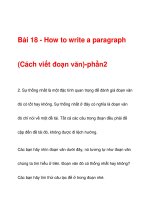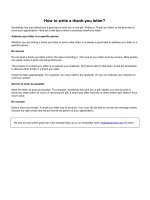How to write a biz letter
Bạn đang xem bản rút gọn của tài liệu. Xem và tải ngay bản đầy đủ của tài liệu tại đây (110.11 KB, 2 trang )
The
series
How to write a business letter
Please turn over
Layout
Your company will have its own ideas on how a letter should be laid out, but when writing in
English, please remember to start with the greeting: Dear
, which should be on a line on its
own. If you use a subject heading (e.g. Business Skills Course), it comes
after
the greeting.
The letter should have three main sections:
• an opening, where you say why you are writing, often with a reference to the past
• the main message of the letter
• a closing section, usually with a reference to the future
At the end of the letter, underneath your signature, you should always type your name and job
title (and, if appropriate, your department) –
in that order
. Giving your name obviously will
help the person receiving your letter if they cannot read your signature! But it also allows you
to say how you wish to be addressed:
e.g. Mary Caversham (Mrs) or Mrs M.V. Caversham
Simon James (Dr) or Dr S. James
Key phrases
• Opening and closing greetings:
Dear Sir or Madam / Sir / Madam →
→→
→ Yours faithfully
Dear Mr / Mrs / Miss / Ms Smith →
→→
→ Yours sincerely
Dear John / Mary →
→→
→ Best wishes
• Ways of starting a letter:
We are writing to enquire about …
I am writing in connection with …
We are interested in … and we would like to know …
• Ways of referring to a letter / invoice / phone call / etc. you have received:
Thank you for your letter of [date] asking if / enquiring about / enclosing / concerning
With reference to your …[something written]
Further to our … [letter, telephone conversation]
• Giving good / bad news:
I am pleased / delighted / happy to tell / inform / advise you that …[good news]
I regret / am sorry to tell / inform / advise you that … [bad news]
The
series
How to write a business letter
English support, Business House (PO Box 618), Jernbanegade 23 B, DK-4000 Roskilde, Denmark. Tel. (+45) 46 30 50 67
e-mail: web site: www.englishsupport.dk
Key phrases (continued)
• Saying what you can and cannot do:
We are able to …
We are unable to …
We have been forced to …
• Apologising:
We must apologise for …
We are extremely sorry about …
We hope this has not caused you too
much inconvenience.
• Giving reasons:
This is due to / owing to / as a result of / because of (the fact that) …
• Requesting action: If it is urgent, you could add:
Please could you … as soon as possible
We would be grateful if you could … without delay
We would appreciate it if you could … immediately
It would be helpful if you could … right away
Would it be possible for you to …?
• Requesting information:
Please could you inform us (about / if) …
We would be grateful if you could let us know (about / if) …
We would appreciate it if you could give us further details about …
We would like to know (about / if) …
• Ways of closing a letter:
I look forward to receiving your reply / order / brochure / etc.
Looking forward to hearing from you.
Please contact me if you need any further information.
I hope this information will help you.
Questions of style
As we have seen there are a lot of
polite
expressions in English business letters, but they are
generally less
formal
in tone than Danish business letters. So if you are trying to translate a
Danish expression into English, it is a good idea to turn it into ordinary everyday Danish first
and then translate it. However, your written English should
not
contain those shortened forms
we use so much in the spoken word (I’m → I am, I’ll → I will, I don’t → I do not, etc.).
The date:
There are a lot of different ways of writing the date in English, but if you write the
date like this:
… then everybody will know what you mean. Remember the capital letter for the month.
23 May 2006









